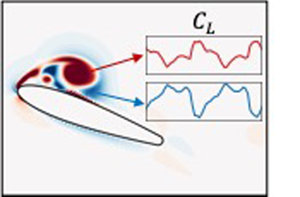Crossref Citations
This article has been cited by the following publications. This list is generated based on data provided by
Crossref.
Ong, Muk Chen
and
Yin, Guang
2022.
On the three-dimensional wake flow behind a normal flat plate.
Physics of Fluids,
Vol. 34,
Issue. 1,
Seo, Jung-Hee
and
Mittal, Rajat
2022.
Improved swimming performance in schooling fish via leading-edge vortex enhancement.
Bioinspiration & Biomimetics,
Vol. 17,
Issue. 6,
p.
066020.
Zhang, Kai
and
Taira, Kunihiko
2022.
Laminar vortex dynamics around forward-swept wings.
Physical Review Fluids,
Vol. 7,
Issue. 2,
Seo, Jung-Hee
Menon, Karthik
and
Mittal, Rajat
2022.
A method for partitioning the sources of aerodynamic loading noise in vortex dominated flows.
Physics of Fluids,
Vol. 34,
Issue. 5,
Menon, Karthik
Kumar, Sushrut
and
Mittal, Rajat
2022.
Contribution of spanwise and cross-span vortices to the lift generation of low-aspect-ratio wings: Insights from force partitioning.
Physical Review Fluids,
Vol. 7,
Issue. 11,
Aghaei-Jouybari, Mostafa
Seo, Jung-Hee
Yuan, Junlin
Mittal, Rajat
and
Meneveau, Charles
2022.
Contributions to pressure drag in rough-wall turbulent flows: Insights from force partitioning.
Physical Review Fluids,
Vol. 7,
Issue. 8,
2023.
Evidence and physical mechanism for vortex-induced vibration of a bluff body without an afterbody.
Physics of Fluids,
Vol. 35,
Issue. 6,
Li, Zhen-Yao
Feng, Li-Hao
Wang, Tong
and
Liang, Yan
2023.
Lift generation mechanism of the leading-edge vortex for an unsteady plate.
Journal of Fluid Mechanics,
Vol. 972,
Issue. ,
Zhu, Yuanhang
Lee, Howon
Kumar, Sushrut
Menon, Karthik
Mittal, Rajat
and
Breuer, Kenneth
2023.
Force moment partitioning and scaling analysis of vortices shed by a 2D pitching wing in quiescent fluid.
Experiments in Fluids,
Vol. 64,
Issue. 10,
Zhu, Yuanhang
and
Breuer, Kenneth
2023.
Flow-induced oscillations of pitching swept wings: stability boundary, vortex dynamics and force partitioning.
Journal of Fluid Mechanics,
Vol. 977,
Issue. ,
Li, Gen
Li, Wenhua
Janocha, Marek Jan
Yin, Guang
and
Ong, Muk Chen
2023.
Large eddy simulations of flow past an inclined circular cylinder: Insights into the three-dimensional effect.
Physics of Fluids,
Vol. 35,
Issue. 11,
Nazvanova, Anastasiia
and
Ong, Muk Chen
2023.
A data-driven reduced-order model based on long short-term memory neural network for vortex-induced vibrations of a circular cylinder.
Physics of Fluids,
Vol. 35,
Issue. 6,
Gao, An-Kang
Cantwell, Chris D.
Son, Onur
and
Sherwin, Spencer J.
2023.
Three-dimensional transition and force characteristics of low-Reynolds-number flows past a plunging airfoil.
Journal of Fluid Mechanics,
Vol. 973,
Issue. ,
Seo, Jung-Hee
Zhang, Yang
Mittal, Rajat
and
Cattafesta, Louis N.
2023.
Vortex-induced sound prediction of slat noise from time-resolved particle image velocimetry data.
Experiments in Fluids,
Vol. 64,
Issue. 5,
Ribeiro, Jean Helder M.
and
Taira, Kunihiko
2023.
Resolvent-based analysis of low-Reynolds-number separated flows around tapered wings.
Le Fouest, Sébastien
Fernex, Daniel
and
Mulleners, Karen
2023.
Time scales of dynamic stall development on a vertical-axis wind turbine blade.
Flow,
Vol. 3,
Issue. ,
Mohaghar, Mohammad
Connor, Angelica A.
Wu, Shuai
Zhao, Ruike Renee
and
Webster, Donald R.
2024.
Effects of symmetry-breaking mechanisms on the flow field around magnetic-responsive material appendages that mimic swimming strokes.
Physical Review Fluids,
Vol. 9,
Issue. 2,
Bouard, Florian
Jardin, Thierry
and
David, Laurent
2024.
Hovering flapping wings with dynamic twist.
Physics of Fluids,
Vol. 36,
Issue. 11,
Kumar, Samvit
and
Eyink, Gregory L.
2024.
A Josephson–Anderson relation for drag in classical channel flows with streamwise periodicity: Effects of wall roughness.
Physics of Fluids,
Vol. 36,
Issue. 9,
Raut, Harshal S.
Seo, Jung-Hee
and
Mittal, Rajat
2024.
Hydrodynamic performance and scaling laws for a modelled wave-induced flapping-foil propulsor.
Journal of Fluid Mechanics,
Vol. 999,
Issue. ,




